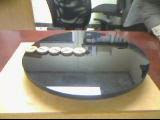What does the typical American think of upon hearing the word "homework?" While I have no psychomological evidence of this, I suspect that the word is generally considered to be synonymous with "rote drill," and has a profoundly negative connotation. On one hand, this is silly -- homework in any subject does not have to consist merely of rote drill.
(What's wrong with rote drill, anyway? I don't see the National Association of Music Educators campaigning to stop making violinists learn their scales; I don't see the National Association of Football Coaches minimizing the importance of conditioning, blocking, and tackling drills. Done properly, and with the correctly limited scope, rote drill at any level of any subject is an important part of learning. Anyway. Ahem.)
Physics homework in particular does not, or at least should not, generally consist of rote drill. Homework problems are used for practice, sure, but students are practicing the skills of creative problem solving, they're practicing to eliminate their crazy misconceptions, they're practicing their ability to explain concepts with reference to a relevant equation... Doing the homework, and moreover doing homework problems seriously and carefully and correctly, is an integral part of learning physics.
Nevertheless, students do not always take homework seriously. In some upper level physics classes in particular, these very smart students say, I don't need to practice, I can just perform on the test. (Then they perform poorly on the test because they didn't practice, and they say physics is just too hard.) How do we get students to pay attention to homework?
Well, it starts (but does not end) with the homework grade. I put a score on homework problems every night or two. This score explicitly counts for 30% of students' course grade. Of course, even with that explicit carrot, my lower level students do not pay appropriate attention to the homework. They turn in hastily done crap, then just sigh when they see that their answer was wrong. It never occurs to them to check BEFORE class whether their answers were correct; it never occurs to them that it would be a good idea to understand WHY their answers were wrong. So the grade itself is a necessary but not sufficient motivator.
At a Virginia AP physics workshop, a teacher reported that he was forbidden by his administration from counting homework more than a token amount toward the course grade. While I stared open-mouthed in a state of flabbergastation, others chimed in that they were under the same restriction. But one clever physics teacher in my workshop had a solution...
I don't call my assignments "homework" precisely to avoid the negative connotation. I use the phrase "problem sets" or "nightly problems," and I regularly make the comparison to the English essay -- I'm asking for the equivalent of a couple of well-written paragraphs every night in an English class. The woman in my workshop took my phrasing and analogy a step further.
"Just call the homework an 'assessment'," she said. "English teachers are allowed to count a series of take-home writing assignments as equivalent to a test. So, we do the same thing. These problem sets are the precise equivalent to a writing assignment, so they will be counted just as the English department counts them."
And perhaps that trick might help the students as well as satisfy the clueless administrator. If a student hears "this counts as a test," his effort seems to double. I've noticed that students will repeatedly make the same kinds of mistakes on homework problems, but if they get the same exact question wrong on a "quiz" in class, suddenly they start remembering.
Why does the psychology of "homework" seem to work against the legitimate goals of nightly assignments? I don't pretend to know. All I can do is make the observation, and then use the observation to the benefit of my class and my students.
GCJ














